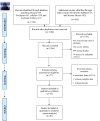Effects of Conjugated Linoleic Acid Intake in the Form of Dietary Supplement or Enriched Food on C-Reactive Protein and Lipoprotein (a) Levels in Humans: A Literature Review and Meta-Analysis
- PMID: 31582860
- PMCID: PMC6754536
- DOI: 10.30476/IJMS.2019.44949
Effects of Conjugated Linoleic Acid Intake in the Form of Dietary Supplement or Enriched Food on C-Reactive Protein and Lipoprotein (a) Levels in Humans: A Literature Review and Meta-Analysis
Abstract
Background: C-reactive protein (CRP) and lipoprotein (a) (Lp[a]) play essential roles in cardiovascular disease incidence. This study aimed to review the association between the intake of conjugated linoleic acid (CLA) in the form of dietary supplement or enriched food with different treatment durations and the levels of Lp(a) and CRP in human studies.
Methods: All the articles published in Cochrane Library, ProQuest, Scopus, and Google Scholar from November 2014 to October 2015 were searched and the clinical trials on the effects of CLA on Lp(a) and CRP levels were assessed. Of the 2249 articles initially retrieved, 21 eligible randomized clinical trials were enrolled in this systematic review. The publication dates of the eligible articles ranged from 2005 to 2013. The mean difference and the standard deviation of changes in CRP and Lp(a) levels in intervention and control groups were used as effect-size measures for meta-analysis. The obtained data from the eligible randomized controlled trials were meta-analyzed using Stata, version 13.
Results: The intake of CLA as a dietary supplement led to a significant increase in CRP levels (standardized mean difference [SMD]=0.41, 95% CI: 0.28 to 0.54; P=0.001). Subgroup analysis based on the duration of CLA consumption showed that CLA consumption more than 24 weeks resulted in a significant increase in the levels of CRP (SMD=0.52, 95% CI: 0.36 to 0.68; P=0.001) and Lp(a) (SMD=0.24, 95% CI: 0.01 to 0.47; P=0.04).
Conclusion: The current systematic review and meta-analysis showed that the long-term consumption of CLA increases the levels of CRP and Lp(a).
Keywords: C-reactive protein; Lipoprotein (a); Meta-analysis; Conjugated linoleic acid.
Copyright: © Iranian Journal of Medical Sciences.
Figures







References
-
- Lambert EV, Goedecke JH, Bluett K, Heggie K, Claassen A, Rae DE, et al. Conjugated linoleic acid versus high-oleic acid sunflower oil: effects on energy metabolism, glucose tolerance, blood lipids, appetite and body composition in regularly exercising individuals. Br J Nutr. 2007;97:1001–11. doi: 10.1017/S0007114507172822. - DOI - PubMed
-
- Mougios V, Matsakas A, Petridou A, Ring S, Sagredos A, Melissopoulou A, et al. Effect of supplementation with conjugated linoleic acid on human serum lipids and body fat. J Nutr Biochem. 2001;12:585–94. - PubMed
-
- Rice BH, Kraft J, Destaillats F, Bauman DE, Lock AL. Ruminant-produced trans-fatty acids raise plasma HDL particle concentrations in intact and ovariectomized female Hartley guinea pigs. J Nutr. 2012;142:1679–83. doi: 10.3945/jn.112.160077. [ PMC Free Article] - DOI - PMC - PubMed
Publication types
LinkOut - more resources
Full Text Sources
Research Materials
Miscellaneous
